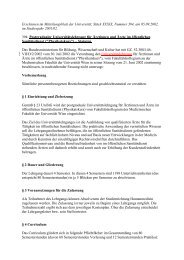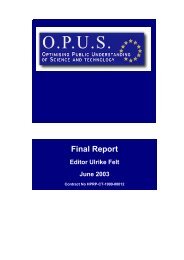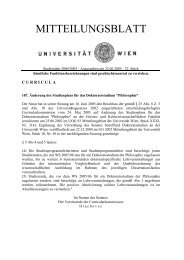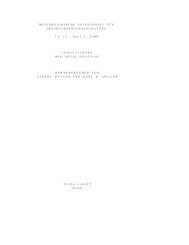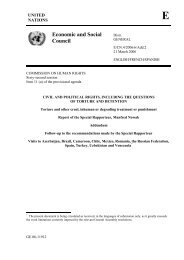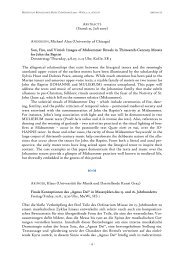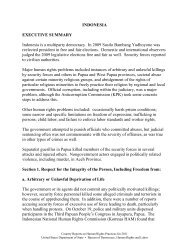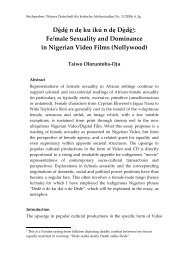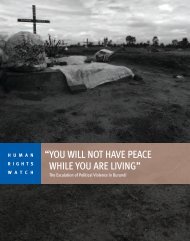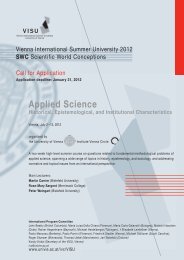Delivered Into Enemy Hands - Human Rights Watch
Delivered Into Enemy Hands - Human Rights Watch
Delivered Into Enemy Hands - Human Rights Watch
You also want an ePaper? Increase the reach of your titles
YUMPU automatically turns print PDFs into web optimized ePapers that Google loves.
CIA Rendition Transportation Procedures<br />
The accounts of many former detainees subjected to CIA renditions between the years 2002-2005 show<br />
standardized treatment during transfer. In most cases, the detainee was stripped of his clothes, photo-<br />
graphed naked, and administered a body cavity search (rectal examination). Some detainees described the<br />
insertion of a suppository at that time. The detainee was then dressed in a diaper. His ears were plugged,<br />
headphones were placed on his head, he was blindfolded or provided black goggles, and his head was<br />
wrapped with bandages and adhesive tape. The detainee’s arms and legs were shackled and he was put into<br />
the transportation vehicle.123 (Hereinafter “CIA rendition transportation procedures”).<br />
The UN Standard Minimum Rules for the Treatment of Prisoners allow the use of instruments of restraint when<br />
prisoners are being transferred. However, some instruments may never be used, such as chains or irons, and<br />
others, including handcuffs and straitjackets, shall never be applied as a punishment.124 The transfer of a<br />
prisoner also does not permit treatment that would amount to torture or cruel, inhuman, or degrading<br />
treatment.125 While the US was entitled to use constraints as necessary for transporting detainees by plane,<br />
some of these methods, particularly when used in conjunction with others, appear intended to punish the<br />
detainee or were, at a minimum, degrading.<br />
123 See Glenn L. Carle, The Interrogator (New York: Nation Books, 2011), p. 191, n. 2; Amnesty International, Below the Radar:<br />
Secret Flights to Torture and ‘Disappearance, April 5, 2006, AMR 51/051/2006,<br />
http://www.amnesty.org/en/library/info/AMR51/051/2006/en (accessed July 30, 2012) (describing the experience of three<br />
Yemeni detainees—Muhammad Bashmilah, Salah Qaru, and Muhammad al-Assad—while in CIA custody), p. 12; Declaration<br />
of Mohammed Farag Ahman Bashmilah in Support of the Plaintiffs’ Motion to Dismiss or, in the Alternative, for Summary<br />
Judgment (hereinafter “Bashmilah Declaration”), Mohamed v. Jeppesen Dataplan, Inc., 539 F. Supp. 2d 1128 (N.D. Cal. 2008),<br />
(subsequently reversed by Mohamed v. Jeppesen Dataplan, Inc., 614 F.3d 1070 (9th Cir. 2010)(cert. denied May 2011)),<br />
http://www.chrgj.org/projects/docs/declarationofbashmilah.pdf (accessed May 27, 2012), paras. 37-40; Craig S. Smith and<br />
Souad Mekhennet, “Algerian Tells of Dark Term in U.S. <strong>Hands</strong>,” July 7, 2006, New York Times,<br />
http://www.nytimes.com/2006/07/07/world/africa/07algeria.html?_r=1&pagewanted=all (accessed July 30, 2012)<br />
(describing the treatment of Algerian detainee, Laid Saidi, under CIA custody); International Committee for the Red Cross,<br />
“ICRC Report on the treatment of Fourteen ‘High Value Detainees’ in CIA Custody,” February 2007,<br />
http://assets.nybooks.com/media/doc/2010/04/22/icrc-report.pdf (accessed July 30, 2012), p. 6-7 (describing the common<br />
treatment and experience of 14 “high value” detainees under CIA custody); <strong>Human</strong> <strong>Rights</strong> <strong>Watch</strong>, Ghost Prisoner, February<br />
2007, http://www.hrw.org/sites/default/files/reports/us0207webwcover.pdf, p. 24, (describing the experience of detainee<br />
Marwan Jabour); Amnesty International, A Case to Answer: From Abu Ghraib to Secret CIA custody: The Case of Khaled al-<br />
Maqtari, March 2008, AMR 51/013/2008, http://www.amnesty.org/en/library/info/AMR51/013/2008/en (accessed July 30,<br />
2012), p. 12; ACLU of Northern California, “Biography of Plaintiff Ahmed Agiza,”<br />
https://www.aclunc.org/cases/active_cases/jeppesen/biography_of_plaintiff_ahmed_agiza.shtml (accessed July 30, 2012);<br />
and ACLU, “Witness: Khaled El-Masri-Victim of Extraordinary Rendition,” July 14, 2006, http://www.aclu.org/humanrights/witness-khaled-el-masri-victim-extraordinary-rendition<br />
(accessed July 30, 2012).<br />
124 Standard Minimum Rules for the Treatment of Prisoners, adopted Aug. 30, 1955, by the First United Nations Congress on the<br />
Prevention of Crime and the Treatment of Offenders, U.N. Doc. A/CONF/611, annex I, E.S.C. res. 663C, 24 U.N. ESCOR Supp. (No. 1)<br />
at 11, U.N. Doc. E/3048 (1957), amended E.S.C. res. 2076, 62 U.N. ESCOR Supp. (No. 1) at 35, U.N. Doc. E/5988 (1977), rule 33.<br />
125 International Covenant on Civil and Political <strong>Rights</strong> (ICCPR), adopted December 16, 1966, G.A. Res. 2200A (XXI), 21 U.N.<br />
GAOR Supp. (No. 16) at 52, U.N. Doc. A/6316 (1966), 999 U.N.T.S. 171, entered into force March 23, 1976, art. 7; Convention<br />
against Torture and Other Cruel, Inhuman or Degrading Treatment or Punishment (Convention against Torture), adopted<br />
December 10, 1984, G.A. res. 39/46, annex, 39 U.N. GAOR Supp. (No. 51) at 197, U.N. Doc. A/39/51 (1984), entered into force<br />
June 26, 1987, arts. 1 and 16.<br />
DELIVERED INTO ENEMY HANDS 36




